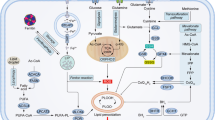Abstract
Purpose
To determine whether FTY720, a sphingosine-1-phosphate (S1P) receptor modulator, would protect sinusoid endothelial cells (SECs) from radiation injury in vitro.
Materials and methods
The effect of FTY720 on the viability of irradiated human liver SECs were examined by MTT assay or FACS analysis. The effect of FTY720 on the survival of hepatocellular carcinoma cell line, HepG2 and McA-RH7777, were determined by clonogenic assays. The activation of Akt pathway was tested by western bolt.
Results
FTY720 increases the survival of irradiated SECs; in contrast, it does not appear to be radioprotective of tumor cells. Furthermore, the activation of Akt pathway was confirmed in the protective effect of FTY720 on SECs.
Conclusion
These results suggest that FTY720 will be a potential therapeutic protector for the SEC apoptosis during RILD.





Similar content being viewed by others
References
Lawrence TS, Robertson JM, Anscher MS, et al. Hepatic toxicity resulting from cancer treatment. Int J Radiat Oncol Biol Phys 1995;31(5):1237–1248
Alati T, Eckl P, Jirtle RL. An in vitro micronucleus assay for determining the radiosensitivity of hepatocytes. Radiat Res 1989;119(3):562–568
Alati T, Van Cleeff M, Strom SC, et al. Radiation sensitivity of adult human parenchymal hepatocytes. Radiat Res 1988;115(1):152–160
Jirtle RL, DeLuca PM, Hinshaw WM, et al. Survival of parenchymal hepatocytes irradiated with 14.3 MeV neutrons. Int J Radiat Oncol Biol Phys 1984;10(6):895–899
Jirtle RL, Michalopoulos G, McLain JR, et al. Transplantation system for determining the clonogenic survival of parenchymal hepatocytes exposed to ionizing radiation. Cancer Res 1981;41(9 Pt 1):3512–3518
Jirtle RL, Michalopoulos G, Strom SC, et al. The survival of parenchymal hepatocytes irradiated with low and high LET radiation. Br J Cancer Suppl 1984;6:197–201
Reed GB Jr., Cox AJ Jr. The human liver after radiation injury. A form of veno-occlusive disease. Am J Pathol 1966;48(4):597–611
Fajardo LF, Colby TV. Pathogenesis of veno-occlusive liver disease after radiation. Arch Pathol Lab Med 1980;104(11):584–588
Yamanouchi K, Zhou H, Roy-Chowdhury N, et al. Hepatic irradiation augments engraftment of donor cells following hepatocyte transplantation. Hepatology 2009;49(1):258–267
Sun X, Shikata Y, Wang L, et al. Enhanced interaction between focal adhesion and adherens junction proteins: involvement in sphingosine 1-phosphate-induced endothelial barrier enhancement. Microvasc Res 2009;77(3):304–313
Moriue T, Igarashi J, Yoneda K, et al. Sphingosine 1-phosphate attenuates H2O2-induced apoptosis in endothelial cells. Biochem Biophys Res Commun 2008;368(4):852–857
Zheng DM, Kitamura T, Ikejima K, et al. Sphingosine 1-phosphate protects rat liver sinusoidal endothelial cells from ethanol-induced apoptosis: role of intracellular calcium and nitric oxide. Hepatology 2006;44(5):1278–1287
Kwon YG, Min JK, Kim KM, et al. Sphingosine 1-phosphate protects human umbilical vein endothelial cells from serum-deprived apoptosis by nitric oxide production. J Biol Chem 2001;276(14):10627–10633
Bonnaud S, Niaudet C, Pottier G, et al. Sphingosine-1-phosphate protects proliferating endothelial cells from ceramide-induced apoptosis but not from DNA damage-induced mitotic death. Cancer Res 2007;67(4):1803–18011
Bonnaud S, Niaudet C, Legoux F, et al. Sphingosine-1-phosphate activates the AKT pathway to protect small intestines from radiation-induced endothelial apoptosis. Cancer Res 2010;70(23):9905–9915
Kolesnick R, Fuks Z. Radiation and ceramide-induced apoptosis. Oncogene 2003;22(37):5897–5906
Natarajan V, Dudek SM, Jacobson JR, et al. Sphingosine-1-phosphate, FTY720, and sphingosine-1-phosphate receptors in the pathobiology of acute lung injury. Am J Respir Cell Mol Biol 2013;49(1):6–17
Stessin AM, Gursel DB, Schwartz A, et al. FTY720, sphingosine 1-phosphate receptor modulator, selectively radioprotects hippocampal neural stem cells. Neurosci Lett 2012;516(2):253–258
Vainshtein JM, Kabarriti R, Mehta KJ, et al. Bone marrow-derived stromal cell therapy in cirrhosis: clinical evidence, cellular mechanisms, and implications for the treatment of hepatocellular carcinoma. Int J Radiat Oncol Biol Phys 2014;89(4):786–803
Harada J, Foley M, Moskowitz MA, et al. Sphingosine-1-phosphate induces proliferation and morphological changes of neural progenitor cells. J Neurochem 2004;88(4):1026–1039
Kimura A, Ohmori T, Ohkawa R, et al. Essential roles of sphingosine 1-phosphate/S1P1 receptor axis in the migration of neural stem cells toward a site of spinal cord injury. Stem Cells 2007;25(1):115–124
Mizugishi K, Yamashita T, Olivera A, et al. Essential role for sphingosine kinases in neural and vascular development. Mol Cell Biol 2005;25(24):11113–11121
Mathew B, Jacobson JR, Berdyshev E, et al. Role of sphingolipids in murine radiation-induced lung injury: protection by sphingosine 1-phosphate analogs. FASEB J 2011;25(10):3388–3400
Morita Y, Perez GI, Paris F, et al. Oocyte apoptosis is suppressed by disruption of the acid sphingomyelinase gene or by sphingosine-1-phosphate therapy. Nat Med 2000;6(10):1109–1114
Roninson IB, Broude EV, Chang BD. If not apoptosis, then what? Treatment-induced senescence and mitotic catastrophe in tumor cells. Drug Resist Updates 2001;4(5):303–313
Hannun YA. Functions of ceramide in coordinating cellular responses to stress. Science 1996;274(5294):1855–1859
Edwards E, Geng L, Tan J, et al. Phosphatidylinositol 3-kinase/Akt signaling in the response of vascular endothelium to ionizing radiation. Cancer Res 2002;62(16):4671–4677
Compliance with ethical requirements and Conflict of interest
All procedures followed were in accordance with the ethical standards of the responsible committee on human experimentation (institutional and national) and with the Helsinki Declaration of 1975, as revised in 2008. Informed consent was obtained from all patients for being included in the study. This article does not contain any studies with human or animal subjects. Shu-Min Zhang, Yi-Xing Chen, Jing Sun, Lei Guo, Zhao-Chong Zeng declare that they have no conflict of interest.
Author information
Authors and Affiliations
Corresponding author
Additional information
Shu-Min Zhang and Yi-Xing Chen contributed equally to this work and should be considered as co-first authors.
Rights and permissions
About this article
Cite this article
Zhang, SM., Chen, YX., Sun, J. et al. FTY720, a sphingosine-1-phosphate (S1P) receptor modulator, protects sinusoid endothelial cells from radiation injury in vitro. Hepatol Int 9, 149–154 (2015). https://doi.org/10.1007/s12072-014-9590-0
Received:
Accepted:
Published:
Issue Date:
DOI: https://doi.org/10.1007/s12072-014-9590-0




